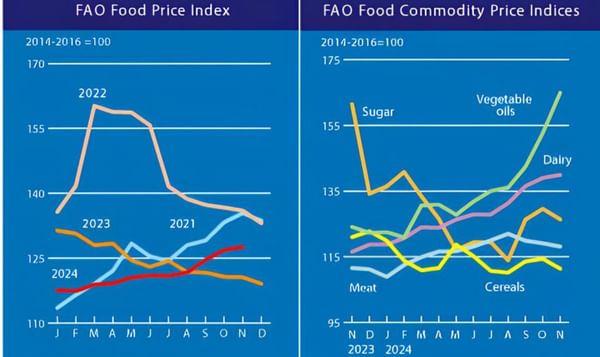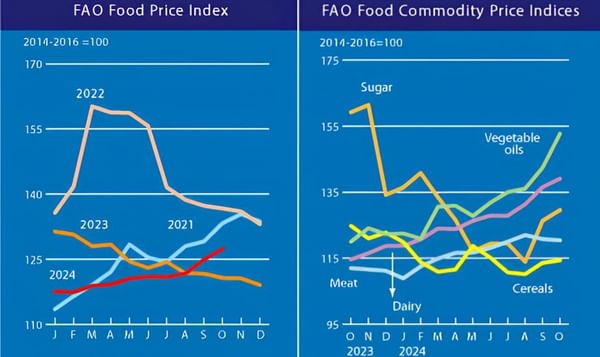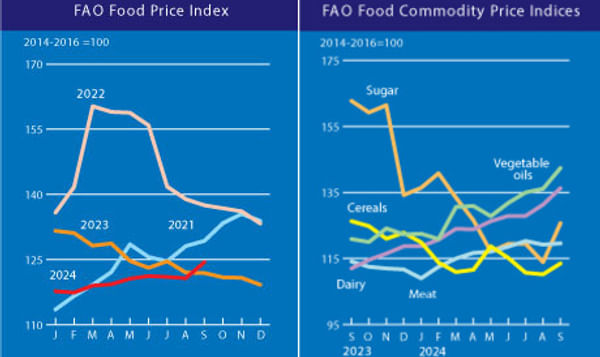After three months of declining food prices, the FAO Food price index increased in May.
FAO Food Price Index rebounds in May

The FAO Food Price Index (FFPI) averaged 172.6 points in May 2017, up 3.7 points (2.2 percent) from April and nearly 16 points (10 percent) higher than its May 2016 level.
The rebound in the value of the Index followed three months of consecutive declines. With the exception of sugar, all other commodity indices used in the calculation of the FFPI increased in May.
The FAO Cereal Price Index averaged 148.1 points in May, up 2 points (1.4 percent) from April, but still 4.4 points (2.9 percent) below its value of May 2016.
Weather developments and stronger trade activity underpinned wheat export prices, while strong demand for higher quality Indica rice drove up international rice prices for the sixth-successive month. Large global availabilities prevented strong gains in maize export prices.
The FAO Vegetable Oil Price Index averaged 168.7 points in May, posting a month-on-month increase of 7.6 points (or 4.7 percent) – after three months of consecutive declines.
The May reversal in trend mainly reflects rising palm and soy oil prices. While palm oil quotations firmed on rising global import demand, which kept world inventories low, soy oil prices rose on expectations of continued robust consumption, in particular in the United States. In both markets, unusually strong demand outweighed the price-depressing effect of anticipated improvements in global supplies.
The FAO Dairy Price Index averaged 193 points in May, up 9.5 points (5.1 percent) from April and as much as 51 percent from May 2016.
In spite of the latest increase, the index is still 30 percent below its peak reached in February 2014. Quotations of all the dairy products that compose the index rose in May. In the case of butter, firm domestic demand in Europe and North America provided support to prices, while ample intervention stocks in the EU limited the increase in skim milk powder prices.
The FAO Meat Price Index averaged 171.7 points in May, up 2.5 points (1.5 percent) from April, continuing the trend of modest price increases observed since the beginning of the year.
Quotations for pig, bovine and ovine meat all rose, while those for poultry meat were stable. Pig meat prices increased on firm demand, while bovine meat prices gained ground amid limited export availabilities from Oceania. Meanwhile, ovine meat prices rose for the third consecutive month, bolstered by constrained export supply.
The FAO Sugar Price Index averaged 227.9 points in May, down 5.4 points (2.3 percent) from April and marking a 13-month low. Sugar prices were heavily affected by higher-than-expected sugar output in Brazil’s centre-south region, combined with the sudden slide in the Brazilian Real, which discouraged crush for ethanol in the domestic market in favour of relatively more lucrative sugar exports.
Expectations of larger exports from Pakistan and China’s decision to impose high duties on imports beyond its WTO tariff-rate quota (TRQ) commitment exerted additional downward pressure on international sugar prices.
The rebound in the value of the Index followed three months of consecutive declines. With the exception of sugar, all other commodity indices used in the calculation of the FFPI increased in May.
The FAO Cereal Price Index averaged 148.1 points in May, up 2 points (1.4 percent) from April, but still 4.4 points (2.9 percent) below its value of May 2016.
Weather developments and stronger trade activity underpinned wheat export prices, while strong demand for higher quality Indica rice drove up international rice prices for the sixth-successive month. Large global availabilities prevented strong gains in maize export prices.
The FAO Vegetable Oil Price Index averaged 168.7 points in May, posting a month-on-month increase of 7.6 points (or 4.7 percent) – after three months of consecutive declines.
The May reversal in trend mainly reflects rising palm and soy oil prices. While palm oil quotations firmed on rising global import demand, which kept world inventories low, soy oil prices rose on expectations of continued robust consumption, in particular in the United States. In both markets, unusually strong demand outweighed the price-depressing effect of anticipated improvements in global supplies.
The FAO Dairy Price Index averaged 193 points in May, up 9.5 points (5.1 percent) from April and as much as 51 percent from May 2016.
In spite of the latest increase, the index is still 30 percent below its peak reached in February 2014. Quotations of all the dairy products that compose the index rose in May. In the case of butter, firm domestic demand in Europe and North America provided support to prices, while ample intervention stocks in the EU limited the increase in skim milk powder prices.
The FAO Meat Price Index averaged 171.7 points in May, up 2.5 points (1.5 percent) from April, continuing the trend of modest price increases observed since the beginning of the year.
Quotations for pig, bovine and ovine meat all rose, while those for poultry meat were stable. Pig meat prices increased on firm demand, while bovine meat prices gained ground amid limited export availabilities from Oceania. Meanwhile, ovine meat prices rose for the third consecutive month, bolstered by constrained export supply.
The FAO Sugar Price Index averaged 227.9 points in May, down 5.4 points (2.3 percent) from April and marking a 13-month low. Sugar prices were heavily affected by higher-than-expected sugar output in Brazil’s centre-south region, combined with the sudden slide in the Brazilian Real, which discouraged crush for ethanol in the domestic market in favour of relatively more lucrative sugar exports.
Expectations of larger exports from Pakistan and China’s decision to impose high duties on imports beyond its WTO tariff-rate quota (TRQ) commitment exerted additional downward pressure on international sugar prices.
Like to receive news like this by email? Join and Subscribe!
Join Our Telegram Channel for regular updates!
精选企业
Sponsored Content
Sponsored Content
Sponsored Content
Sponsored Content
Sponsored Content












